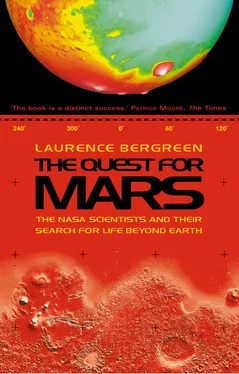NASA expanded its string of Mars missions into a more formal, and better-funded, program of exploration. “The Human Exploration people at the Johnson Space Center came along and said, ‘Okay, we want to fly humans to Mars.’ Dan Goldin set 2018 as a date, but the Johnson Space Center said, ‘Well, we think it should be earlier than that. We’d like to do it by 2011,’” Donna Shirley said. “To decide whether to send humans to Mars by 2011, you need to make a decision by about 2005 that you are going to invest in doing that, and you need to have the information necessary to make the decision. The only way to get the answers by 2005 is to fly by 2001.” Just when it looked as though Mars might get a lot more money, Congress realized that the International Space Station was generating huge cost overruns, and it sucked up money that might have gone to human Mars exploration.
Goldin didn’t give up on the idea of sending people to Mars. He directed scientists at NASA to make plans for an eventual human mission. Although the project was unfunded and unofficial, it was real enough, and the scientists and engineers went at it with the zeal of true believers. Their enterprise went under vague names, such as Beyond Earth Orbit (BEO) and Human Exploration and Development of Space (HEDS), names that meant different things to different people, and wouldn’t upset Congress. But to those within NASA, the names meant one thing: sending people to Mars. So a lot was riding on the success of the little Pathfinder mission; the implications went far beyond the success or failure of its experiments. It was, potentially, the first step in the most ambitious exploration in history, but few outside of NASA realized that.
The loss of Mars Observer meant Pathfinder’s site selection team was forced to rely on twenty-year-old Viking data. Since Pathfinder was designed to plummet to the Martian surface, it would not be able pick and choose a landing site as Viking had. The site would have to be selected in advance, and it had better be good. A lot of the responsibility for selecting a site fell to Matt Golombek, a young geologist. If you can recall the kid in the seventh grade who always seemed a couple of steps ahead of the teacher, let alone the class, and who was wiry and agile and had a way of laughing off anything that bothered him, you have a sense of Matt Golombek. He came to the agency from Rutgers and the University of Massachusetts as one of the new generation of planetary geologists that included Maria Zuber and Jim Garvin. “You only do this because you love it. It’s not like you’re going to get rich or famous. You’re especially not going to get rich,” he says. Although he reports to work at JPL, which is a government facility, he is, like everyone else there, technically employed by Caltech. It’s a peculiar arrangement, which he facetiously likens to a “money-laundering scheme to lower the number of civil servants.” Matt maintains a certain skepticism concerning government work. “You know what they say about civil servants, don’t you? They’re like rusty old guns. They don’t work, and you can’t fire them.”
Despite his youth, Matt brought with him long experience in Mars exploration. “I was the pre-Project Scientist on all the Mars missions before Pathfinder for ten years, and there was a whole string of them. I was brought in originally with something called the Mars Rover Sample Return, which was actually a politically motivated study to work with the Russians, which didn’t go anywhere.” This was followed by assignments on other luckless missions, including Mars Observer. “I think one of the reasons they assigned me to Pathfinder as the Project Scientist was that I was young. Part of their thinking was, ‘Well, it doesn’t matter who we appoint. It’s not going to mean anything.’ I wasn’t sure I even wanted the job, because the mission was an entry, descent, and landing demonstration that would have little or no science of benefit to anyone. What the hell do you need a Project Scientist for? There’s no science, right ? I mean, Pathfinder’s main goal was to land safely, period.”
To achieve even that limited goal, he spent two years mastering every detail of the choices before making his recommendation. The pixels in the old Viking images concealed many potential hazards. “Imagine if you looked at an image to select a potential landing site, and the smallest you see is the size of a football stadium, and you are worried about things that are the size of a meter,” Matt said. “All we had was very coarse, low resolution remote sensing information about Mars, yet we had to guesstimate that the place we would come to rest would be safe, and that the rover could travel out on it. That’s a very difficult job. It was a two-and-a-half year process. We did an exhaustive study of the options, of cost, and of the kind of science you could get at different places.” He had to factor many subtle requirements into his choice. He looked for a spot where Pathfinder’s solar cells would supply power, and where the antennae could communicate with Earth as often as possible. He wanted an area free of mesas, which would confuse Pathfinder’s navigational system. Those and other constraints eliminated ninety percent of the surface of the planet. Geological factors eliminated a number of other tempting targets; if an area was too dusty, too cavernous, or too rocky, it was eliminated from consideration.
There was something else on his mind. What was the point in going all the way to Mars only to land in a dried-up, featureless lake bed and watch the rover go round and round? Why not use the tools they were bringing, the Alpha Proton X-ray spectrometer and the cameras? Why not make Pathfinder a science mission as well as an engineering mission? “Wait a minute,” he told anyone who’d listen, “ we can actually do science .” Perhaps the mission would need a Project Scientist, after all. Matt saw his chance to push against the system and work with the engineers to make room for science. For Pathfinder to accomplish anything significant, it would have to land in a place with attention-grabbing rocks – rocks that would speak volumes about Martian geological history, especially the presence of water, rocks that were big, but not too big. He didn’t want boulders, for instance, and he didn’t want pebbles, either. He wanted, so he said, a “rock mission.” He wanted a “grab bag, a smorgasbord, a potpourri of rocks.” He wanted sermons in stone.
Everyone at JPL recognized that Matt was a very good scientist. Now he demonstrated that he was a very good scientific operator, as well. His gift for caustic repartee concealed considerable shrewdness; depending on his purposes, he could be engagingly cynical, or firm and cool. He was persuasive with his colleagues, lacing his remarks with irony, imparting to all those around him the intoxicating sense that they were being drawn into some grand cosmic joke. Nothing intimidated him, least of all NASA’s bureaucracy. NASA was a bunch of civil servants – c’mon, people, don’t you see the joke in this situation? It was a racket . Caltech was another racket, as was JPL. Then there was the science racket, the engineering racket, the budget racket, and of course, the Mars racket, and they were all susceptible to lobbying and influence if you knew where to apply pressure, which came down to motivating people to do something different. “The hardest part of going to Mars,” Matt once told me, “was getting everyone working on Pathfinder to march in the same direction.”
Unlike most scientists, he was good with the engineers; he appreciated the difficulties they faced. Scientists and engineers often develop adversarial relationships: scientists usually display scant patience for the difficulties of building and operating the instruments, and engineers tend to regard scientists as impractical, arrogant, impossible to please. Stepping into the midst of the fray, Matt pushed back on the scientists, knocking down the number of experiments, and he convinced engineers they could do things they wouldn’t have thought possible. That was a formula for a very successful manager of space science. “You almost have to turn yourself into an engineer,” he said, “because you have to understand what your spacecraft’s doing. Your dominant job as a Project Scientist is to make sure they don’t engineer the science off the mission. It’s not that engineers are dumb, they’re doing the best they can, but they don’t necessarily think about science. And so you sit through interminable meetings waiting for the one silly thing that will pop up and threaten the science. I mean, it’s crazy ! The other aspect, once you get the mission going, is that you have to lead the science team. You have to show them where you’re going. What’s really important? How do you allocate resources? How do you keep people’s egos from getting in the way? That’s very tricky.”
Читать дальше












